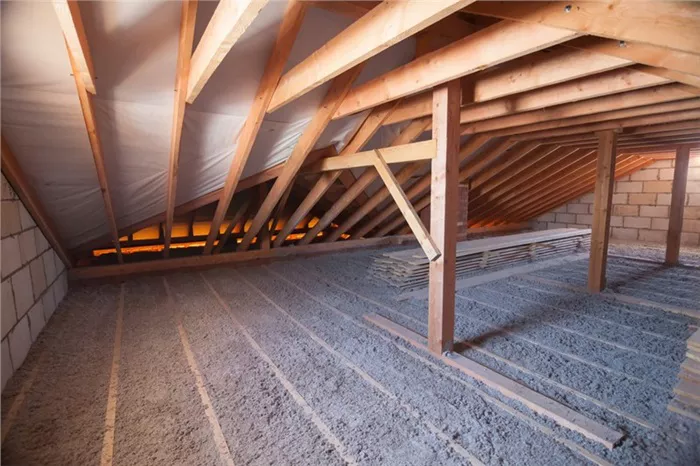Proper insulation in the attic is vital for enhancing energy efficiency, maintaining comfort, and preventing issues such as ice dams and heat loss. The right amount of insulation depends on various factors, including your climate, the type of insulation used, and your home’s specific requirements. This detailed guide provides an in-depth look at determining the appropriate amount of attic insulation.
Understanding R-Value: The Key to Insulation Effectiveness
The R-value measures the thermal resistance of insulation, indicating how well it resists heat flow. The higher the R-value, the better the insulation’s performance. The recommended R-value for attic insulation varies based on geographic location and climate.
R-Value Recommendations by Climate Zone
The U.S. Department of Energy (DOE) provides insulation recommendations based on climate zones. Here’s a breakdown:
Zone 1 (Hot Climates, e.g., Southern Florida): Aim for an R-value of R-30 to R-49. In these regions, insulation focuses on reducing heat gain and keeping indoor spaces cool.
Zone 2 (Warm Climates, e.g., Southern Texas): An R-value of R-30 to R-60 is recommended. This range balances heat retention and energy efficiency.
Zone 3 (Mixed Climates, e.g., Atlanta, GA): For mixed climates, an R-value of R-38 to R-60 is ideal. This accommodates both heating and cooling needs throughout the year.
Zone 4 (Cold Climates, e.g., Denver, CO): Insulation should have an R-value of R-49 to R-60. Cold climates require higher insulation levels to prevent heat loss.
Zone 5 (Very Cold Climates, e.g., Chicago, IL): The recommended R-value is R-49 to R-60 to ensure adequate thermal resistance and energy savings.
Zone 6 (Extremely Cold Climates, e.g., Minneapolis, MN): In these areas, aim for R-49 to R-60 to combat severe cold and minimize heating costs.
Zone 7 & 8 (Arctic Climates, e.g., Alaska): The recommended R-value is R-49 to R-60+. These regions require the highest insulation levels due to extreme temperatures.
See also: How Much Does Spray Foam Insulation Cost?
Types of Insulation and Their Requirements
Different types of insulation offer various R-values and installation methods. Here’s a look at common types and their required thicknesses:
Fiberglass Batt Insulation
Description: Fiberglass batt insulation comes in pre-cut batts or rolls and is often used in attic spaces.
Recommended Thickness: To achieve an R-value of R-30 to R-60, you typically need 10 to 14 inches of fiberglass batt insulation, depending on the desired R-value.
Installation Tips: Ensure the batts are cut to fit snugly between rafters or joists and are not compressed. Proper installation is crucial for effectiveness.
Blown-In Fiberglass or Cellulose Insulation
Description: Blown-in insulation is loose-fill material that is spread evenly across the attic floor.
Recommended Thickness: For R-values between R-30 and R-60, aim for 15 to 20 inches of blown-in insulation.
Installation Tips: Blown-in insulation is ideal for filling gaps and covering irregular spaces. Use a blower machine to distribute the material evenly and achieve the desired depth.
Spray Foam Insulation
Description: Spray foam insulation expands upon application, filling gaps and creating an airtight seal.
Recommended Thickness: To achieve high R-values, typically 6 to 10 inches of spray foam is sufficient. Spray foam offers a high R-value per inch compared to other insulation types.
Installation Tips: Professional installation is recommended for spray foam insulation to ensure proper application and coverage. It can be used in both open and closed-cell forms, with closed-cell spray foam providing higher R-values.
Evaluating Existing Insulation
Before adding insulation, assess your current insulation level:
Measure Thickness
Tools Needed: Use a ruler or tape measure to measure the thickness of your existing insulation.
Assessment: Compare the measured thickness with recommended values for your climate zone.
Inspect for Gaps and Compression
Check for Gaps: Ensure that insulation covers the entire attic floor without gaps or spaces.
Inspect for Compression: Compressed insulation loses effectiveness. Ensure the insulation is evenly distributed and not compressed by stored items or other factors.
Check for Moisture
Look for Signs: Moisture can affect insulation performance and lead to mold growth. Inspect for signs of water damage or mold and address any moisture issues before adding more insulation.
See also: How Much Does Epoxy Flooring Cost?
Insulating Attic Spaces
Proper insulation involves more than just adding material. Consider the following steps:
Seal Air Leaks
Importance: Air leaks around ducts, vents, and wiring can significantly reduce insulation effectiveness and lead to heat loss.
Sealing Methods: Use caulk or foam sealant to close gaps and cracks. Ensure that any penetrations through the attic floor are sealed.
Add Insulation
Appropriate Type: Choose the type of insulation that best suits your needs and budget.
Achieve Desired R-Value: Add insulation to reach the recommended R-value for your climate zone. Follow manufacturer guidelines for installation thickness and coverage.
Ensure Proper Ventilation
Avoid Moisture Buildup: Proper ventilation prevents moisture accumulation, which can damage insulation and lead to other issues.
Install Baffles: Use baffles or vents to maintain airflow and ensure that insulation does not block attic vents.
Professional Assessment
For the most accurate recommendations, consider consulting a professional insulation contractor:
Assessment: Professionals can evaluate your current insulation, recommend the best type and amount of insulation, and ensure proper installation.
Benefits: Professional installation ensures that insulation is applied correctly and meets building codes and energy efficiency standards.
Conclusion
Proper attic insulation is essential for energy efficiency, comfort, and preventing issues such as heat loss and ice dams. The amount of insulation needed depends on factors such as climate, insulation type, and existing conditions. By understanding R-values, evaluating your current insulation, and following proper installation practices, you can achieve optimal insulation performance for your attic. Consulting a professional can provide tailored recommendations and ensure effective insulation, leading to long-term benefits and energy savings for your home.
Related Topics:

